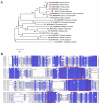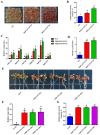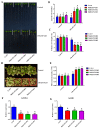Overexpression of MdZAT5, an C2H2-Type Zinc Finger Protein, Regulates Anthocyanin Accumulation and Salt Stress Response in Apple Calli and Arabidopsis
- PMID: 35163816
- PMCID: PMC8836528
- DOI: 10.3390/ijms23031897
Overexpression of MdZAT5, an C2H2-Type Zinc Finger Protein, Regulates Anthocyanin Accumulation and Salt Stress Response in Apple Calli and Arabidopsis
Abstract
Zinc finger proteins are widely involved and play an important role in plant growth and abiotic stress. In this research, MdZAT5, a gene encoding C2H2-type zinc finger protein, was cloned and investigated. The MdZAT5 was highly expressed in flower tissues by qRT-PCR analyses and GUS staining. Promoter analysis showed that MdZAT5 contained multiple response elements, and the expression levels of MdZAT5 were induced by various abiotic stress treatments. Overexpression of MdZAT5 in apple calli positively regulated anthocyanin accumulation by activating the expressions of anthocyanin biosynthesis-related genes. Overexpression of MdZAT5 in Arabidopsis also enhanced the accumulation of anthocyanin. In addition, MdZAT5 increased the sensitivity to salt stress in apple calli. Ectopic expression of MdZAT5 in Arabidopsis reduced the expression of salt-stress-related genes (AtNHX1 and AtABI1) and improved the sensitivity to salt stress. In conclusion, these results suggest that MdZAT5 plays a positive regulatory role in anthocyanin accumulation and negatively regulates salt resistance.
Keywords: MdZAT5; anthocyanin; apple; salt tolerance.
Conflict of interest statement
The authors declare no conflict of interest.
Figures









References
-
- Porta N.L., Bertamini M., Nedunchezhian N., Muthuchelian K. High Irradiance Induced Changes of Photosystem 2 in Young and Mature Needles of Cypress (Cupressus sempervirens L.) Photosynthetica. 2004;42:263–271. doi: 10.1023/B:PHOT.0000040599.63773.ef. - DOI
-
- Meng X., Xing T., Wang X. The role of light in the regulation of anthocyanin accumulation in Gerbera hybrida. Plant Growth Regul. 2004;44:243–250. doi: 10.1007/s10725-004-4454-6. - DOI
MeSH terms
Substances
Grants and funding
LinkOut - more resources
Full Text Sources
Other Literature Sources

